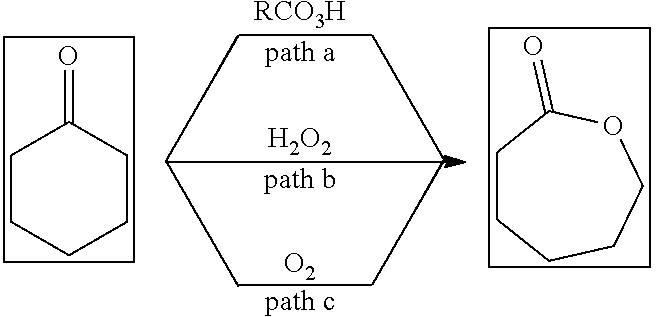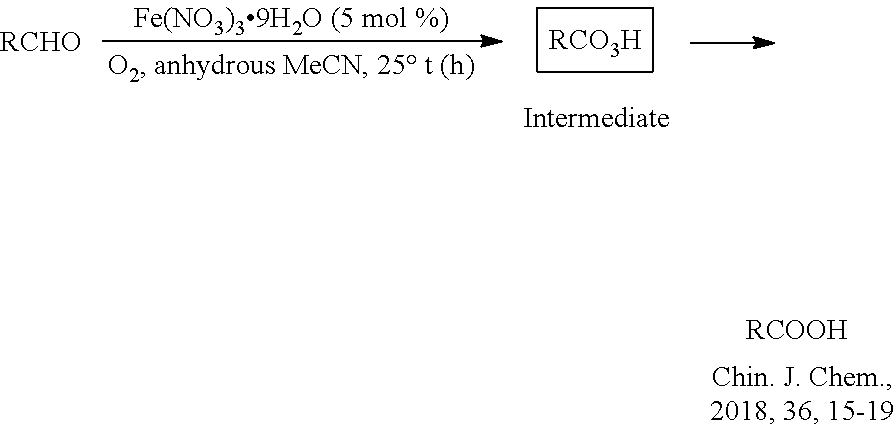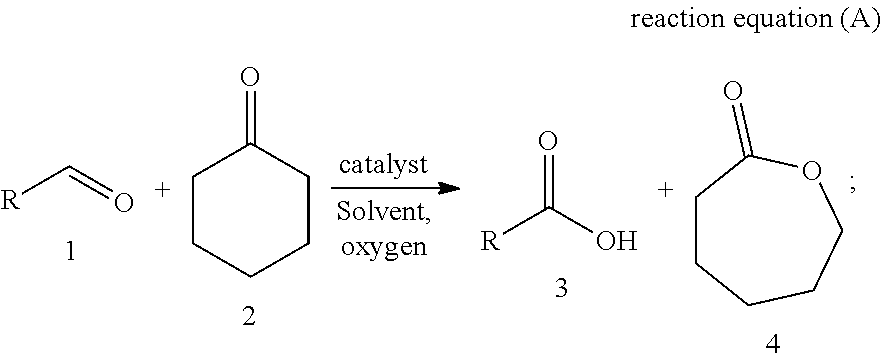Method for co-production of carboxylic acid and epsilon-caprolactone based on aerobic oxidation
a technology of epsilon-caprolactone and carboxylic acid, which is applied in the field of chemical synthesis, can solve the problems of miscibility of high-concentration hydrogen peroxide and organic solvents, and achieve the effect of reducing the risk of toxicity
- Summary
- Abstract
- Description
- Claims
- Application Information
AI Technical Summary
Benefits of technology
Problems solved by technology
Method used
Image
Examples
example 1
[0024]
[0025](Typical procedure) Ferric nitrate nonahydrate (101.9 mg, 0.25 mmol), 1,2-dichloroethane (20 mL) and cyclohexanone (980.2 mg, 10.0 mmol) were added into a three-neck bottle, after replacing the air with oxygen for three times, the propionaldehyde (1.4541 g, 25 mmol) solution in 1,2-dichloroethane (50 mL) was added dropwise at 30° C. over 5 hours. The resulting mixture was stirred at 30° C. until the completion of the reaction. 86% of 3a (with dibromomethane as internal standard, NMR yield) and 72% of 4 (with dibromomethane as internal standard, NMR yield) were obtained.
example 2
[0026]
[0027]Ferric nitrate nonahydrate (100.4 mg, 0.25 mmol), 1,2-dichloroethane (20 mL) and cyclohexanone (980.7 mg, 10.0 mmol) were added into a three-neck bottle, after replacing the air with oxygen for three times, the n-butyraldehyde (1.8045 g, 25 mmol) solution in 1,2-dichloroethane (50 mL) was added dropwise at 30° C. over 5 hours. The resulting mixture was stirred at 30° C. until the completion of the reaction. 100% of 3b (with dibromomethane as internal standard, NMR yield) and 79% of 4 (with dibromomethane as internal standard, NMR yield) were obtained.
example 3
[0028]
[0029]Ferric nitrate nonahydrate (100.0 mg, 0.25 mmol), 1,2-dichloroethane (20 mL) and cyclohexanone (981.5 mg, 10.0 mmol) were added into a three-neck bottle, after replacing the air with oxygen for three times, the n-valeraldehyde (2.1446 g, 25 mmol) solution in 1,2-dichloroethane (50 mL) was added dropwise at 30° C. over 5 hours. The resulting mixture was stirred at 30° C. until the completion of the reaction. 100% of 3c (with dibromomethane as internal standard, NMR yield) and 71% of 4 (with dibromomethane as internal standard, NMR yield) were obtained.
PUM
| Property | Measurement | Unit |
|---|---|---|
| Temperature | aaaaa | aaaaa |
| Time | aaaaa | aaaaa |
| Molar ratio | aaaaa | aaaaa |
Abstract
Description
Claims
Application Information
 Login to View More
Login to View More - R&D Engineer
- R&D Manager
- IP Professional
- Industry Leading Data Capabilities
- Powerful AI technology
- Patent DNA Extraction
Browse by: Latest US Patents, China's latest patents, Technical Efficacy Thesaurus, Application Domain, Technology Topic, Popular Technical Reports.
© 2024 PatSnap. All rights reserved.Legal|Privacy policy|Modern Slavery Act Transparency Statement|Sitemap|About US| Contact US: help@patsnap.com










